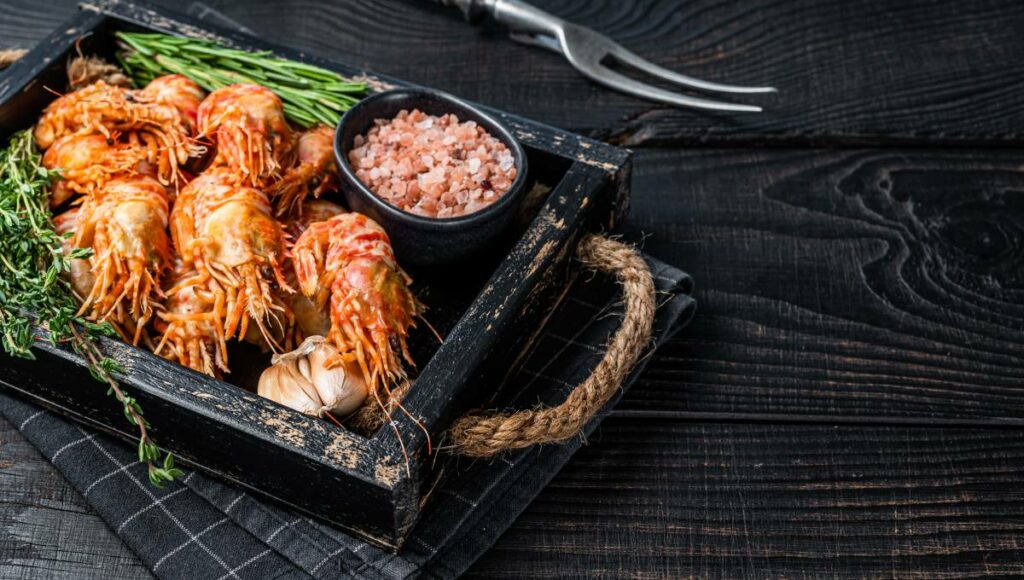Share the post "Can You Eat Shrimp Shells? (And Three Ways to Cook Them Right)"
Shrimp is a popular protein choice in Asian cuisine, owing to its delectable taste. You’ve probably eaten it without the shell plenty of times. But have you ever wondered whether you could eat the shrimp shell?
You can eat shrimp shells because they’re made out of protein, chitin, and minerals, making them edible, digestible, and fairly nutritious. But don’t consume them in surplus or if you’re allergic to shellfish. Plus, shrimp shells, when cooked right, can add depth to your meal’s flavor.
There’s a lot more to discuss when it comes to eating shrimp shells. In this article, we’ll explore why you should eat shrimp shells and a few things you should consider before eating them. We’ll also discuss the best techniques you can apply to make the shrimp shell flavorsome.

Reasons to Eat Shrimp Shells
There’s no actual harm in eating shrimp shells. Instead, you can use them to your advantage. Let’s go over the reasons why you should be eating shrimp shells.
1. Shrimp Shells Come With Health Benefits
Research shows that the consumption of chitosan, a major component of the shrimp shell, can reduce bad cholesterol levels and alleviate good cholesterol. Cholesterol control helps people manage obesity and fight cardiovascular diseases, a significant human killer in the world today.
2. Shrimp Shells Make Meals More Flavorsome
Shrimp shells have no flavor if you don’t cook and season them. But that doesn’t mean you should let them go to waste, especially because they’re excellent captivators of spices, seasoning, and flavors during the cooking process. You can eat them or suck on them for an ultimate dining experience!
Shrimp shells add texture and flavor to your meal and make them look more tempting when cooked with the perfect technique. Plus, you can use them to thicken your broth and stews and bring out the best flavor.
3. Using Shrimp Shells Can Make Cooking Them Less Tedious
Let’s face it, no one likes de-shelling shrimp before cooking them. Most people prefer buying de-shelled and clean shrimp from stores. But it’s not the same as shrimp fresh out of the sea. If you utilize shrimp shells, you can use fresh shrimp in your meals and opt out of the tedious task of deshelling them.
Fun Fact: Cooking shrimp with the shell on can significantly reduce their fishy taste and smell, basically giving you the best of both worlds.
Learn More: What Does Shrimp Taste Like
Things to Consider Before Eating Shrimp Shells
Admittedly, eating shrimp shells has health and flavor benefits but that doesn’t mean you should overconsume them. As always, moderation is key. Some things you should consider before eating all the shrimp shells that come your way are:
1. Shellfish Allergies
Shellfish allergies are one of the most common food allergies and can arise at any point in life – usually during mature years. Allergic people shouldn’t consume shrimp shells or eat foods using them to avoid serious health repercussions.
2. Correlation Between Shrimp Shells And Gout
Shellfish, including shrimp, contain high purine levels. Purine is typically converted to uric acid in the human body and expelled. But if the uric acid level becomes too high, it deposits in the joints as crystals. This medical condition is known as gout.
Even though the shrimp shell contains fewer purines than the actual shrimp, if you’re already suffering from high uric acid levels, it’s not a good idea to consume them.
Three Ways to Cook Shrimp to Get the Best Out of the Shells
Cooking shrimp in a way that makes the shell brittle, thin, and easier to bite through can be a challenge. Let’s look at a couple of ways to get the job done:
1. Fried Shrimp
Clean and pat-dry the shrimp. Marinate it in seasonings and spices of your choice before putting it in the fridge for some time. Meanwhile, heat the oil. Double-coat the shrimp with egg and seasoned flour before frying it in the hot oil. You’ll only need to give it a few minutes in the oil to get perfectly cooked shrimp with an edible shell.
2. Shrimp Stock
If you’re set on not eating shrimp shells, you don’t necessarily have to throw them away. Instead, use them to make shrimp stock. Shrimp shells add incredible flavor depth, making the stock the perfect base for stews, broth, or risotto.
3. Baked/Broiled Shrimp
Clean and pat the shrimp dry, toss them in any oil, and spread them on a baking tray. Season and flavor the shrimp with salt and other spices of your choice. Put the tray in a preheated oven and set the temperature between 120℉ and 150℉. Shrimp cooks pretty quickly so give it 2-5 minutes in the oven or till it develops a pink color.
Learn More: Can You Eat Shrimp Tails? (Risks and Benefits)
Summing Up
Can you eat shrimp shells? Well, this article answers your question in detail by navigating why you shouldn’t shy away from eating shrimp shells and the incredible ways to put them to good use in your meals. Although, do consider that shrimp shells can flare up allergies and gout in certain people.

